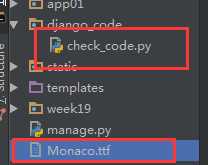标签:
目录
首先了解一下 request.FILES :
字典 request.FILES 中的每一个条目都是一个UploadFile对象。UploadFile对象有如下方法:
1、UploadFile.read():
从文件中读取全部上传数据。当上传文件过大时,可能会耗尽内存,慎用。
2、UploadFile.multiple_chunks():
如上传文件足够大,要分成多个部分读入时,返回True.默认情况,当上传文件大于2.5M时,返回True。但这一个值可以配置。
3、UploadFile.chunks():
返回一个上传文件的分块生成器。如multiple_chunks()返回True,必须在循环中使用chrunks()来代替read()。一般情况下直接使用chunks()就行。
4、UploadFile.name:上传文件的文件名
5、UplaodFile.size:上传文件的文件大小(字节)
models.py
class UploadFile(models.Model):
username =models.CharField(max_length=50)
uploadfile = models.FileField(upload_to=‘./static/‘)#指定的upload目录相对于根目录下media目录
def __str__(self):
return self.username
index.html
<form method="post" enctype="multipart/form-data">
<label>用户名:</label><input type="text" name="username" />
<label>文 件:</label><input type="file" name="uploadfile" />
<input type="submit" value="‘提交" />
</form>
views.py
def index(request):
if request.method == ‘POST‘:
un = request.POST.get(‘username‘)
print(un)
f = request.FILES.get(‘uploadfile‘)#‘uploadfile‘与提交表单中input名一致,多个文件参见getlist()
filename = os.path.join(‘static‘, f.name) #存放内容的目标文件
# 123 = os.path.join(‘static‘, ‘images‘, filename.name)
with open(filename, ‘wb‘) as keys:
for chunk in f.chunks():#chunks()方法将文件切分成为块(<=2.5M)的迭代对象
keys.write(chunk)
#新数据表信息
models.UploadFile.objects.create(username=un, uploadfile=filename)
return HttpResponse(filename + ‘ok‘)
return render_to_response(‘index.html‘, {})
models.py
class UploadFile(models.Model):
username =models.CharField(max_length=50)
uploadfile = models.FileField(upload_to=‘./static/‘)#指定的upload目录相对于根目录下media目录
def __str__(self):
return self.username
mo.html
<form method="post" enctype="multipart/form-data">
{{ uf.username }}
{{ uf.uploadfile }}
<input type="submit" value="‘提交" />
</form>
forms.py
from django import forms
class UploadForm(forms.Form):
username = forms.CharField()
uploadfile = forms.FileField()
views.py
def model(request):
if request.method ==‘POST‘:
uf =forms.UploadForm(request.POST,request.FILES)
if uf.is_valid():
username =uf.cleaned_data[‘username‘]
uploadfile=uf.cleaned_data[‘uploadfile‘]
u = models.UploadFile()
u.username=username
u.uploadfile=uploadfile
u.save()
return HttpResponse(‘ok‘)
uf = forms.UploadForm()
return render_to_response(‘mo.html‘,{‘uf‘:uf})
<div>
{{ uf.uploadfile }}
<input type="button" id="submitj" value="提交" />
</div>
<script src="/static/jquery-2.1.4.min.js"></script>
<script>
$(‘#submitj‘).bind("click",function () {
var file = $(‘#id_uploadfile‘)[0].files[0];
console.log("fff",file);
var form = new FormData();
form.append(‘uploadfile‘, file);
$.ajax({
type:‘POST‘,
url: ‘/mo/‘,
data: form,
processData: false, // tell jQuery not to process the data
contentType: false, // tell jQuery not to set contentType
success: function(arg){
}
})
})
</script>
def UploadFile(request):
print(request.FILES)
uf = forms.uploadForm(request.POST, request.FILES)
print(uf.is_valid())
if uf.is_valid():
upoad = models.UploadFile()
print(123234)
upoad.username = ‘alex‘
upoad.uploadfile = uf.cleaned_data[‘uploadfile‘]
upoad.save()
return render(request,‘ajax.html‘,locals())
from django import forms
class uploadForm(forms.Form):
uploadfile = forms.FileField()
class UploadFile(models.Model):
username =models.CharField(max_length=50)
uploadfile = models.FileField(upload_to=‘./static/‘)#指定的upload目录相对于根目录下media目录
def __str__(self):
return self.username
import io
import os
from django_code import check_code
def check_coder(request):
mstream = io.BytesIO()
img, code = check_code.create_validate_code()
img.save(mstream, "GIF")
request.session["CheckCode"] = code ##写入session
print(mstream.getvalue())
return HttpResponse(mstream.getvalue())
check_code.py 文件

#!/usr/bin/env python #coding:utf-8 import random from PIL import Image, ImageDraw, ImageFont, ImageFilter _letter_cases = "abcdefghjkmnpqrstuvwxy" # 小写字母,去除可能干扰的i,l,o,z _upper_cases = _letter_cases.upper() # 大写字母 _numbers = ‘‘.join(map(str, range(3, 10))) # 数字 init_chars = ‘‘.join((_letter_cases, _upper_cases, _numbers)) def create_validate_code(size=(120, 30), chars=init_chars, img_type="GIF", mode="RGB", bg_color=(255, 255, 255), fg_color=(0, 0, 255), font_size=18, font_type="Monaco.ttf", length=4, draw_lines=True, n_line=(1, 2), draw_points=True, point_chance = 2): ‘‘‘ @todo: 生成验证码图片 @param size: 图片的大小,格式(宽,高),默认为(120, 30) @param chars: 允许的字符集合,格式字符串 @param img_type: 图片保存的格式,默认为GIF,可选的为GIF,JPEG,TIFF,PNG @param mode: 图片模式,默认为RGB @param bg_color: 背景颜色,默认为白色 @param fg_color: 前景色,验证码字符颜色,默认为蓝色#0000FF @param font_size: 验证码字体大小 @param font_type: 验证码字体,默认为 ae_AlArabiya.ttf @param length: 验证码字符个数 @param draw_lines: 是否划干扰线 @param n_lines: 干扰线的条数范围,格式元组,默认为(1, 2),只有draw_lines为True时有效 @param draw_points: 是否画干扰点 @param point_chance: 干扰点出现的概率,大小范围[0, 100] @return: [0]: PIL Image实例 @return: [1]: 验证码图片中的字符串 ‘‘‘ width, height = size # 宽, 高 img = Image.new(mode, size, bg_color) # 创建图形 draw = ImageDraw.Draw(img) # 创建画笔 def get_chars(): ‘‘‘生成给定长度的字符串,返回列表格式‘‘‘ return random.sample(chars, length) def create_lines(): ‘‘‘绘制干扰线‘‘‘ line_num = random.randint(*n_line) # 干扰线条数 for i in range(line_num): # 起始点 begin = (random.randint(0, size[0]), random.randint(0, size[1])) #结束点 end = (random.randint(0, size[0]), random.randint(0, size[1])) draw.line([begin, end], fill=(0, 0, 0)) def create_points(): ‘‘‘绘制干扰点‘‘‘ chance = min(100, max(0, int(point_chance))) # 大小限制在[0, 100] for w in range(width): for h in range(height): tmp = random.randint(0, 100) if tmp > 100 - chance: draw.point((w, h), fill=(0, 0, 0)) def create_strs(): ‘‘‘绘制验证码字符‘‘‘ c_chars = get_chars() strs = ‘ %s ‘ % ‘ ‘.join(c_chars) # 每个字符前后以空格隔开 font = ImageFont.truetype(font_type, font_size) font_width, font_height = font.getsize(strs) draw.text(((width - font_width) / 3, (height - font_height) / 3), strs, font=font, fill=fg_color) return ‘‘.join(c_chars) if draw_lines: create_lines() if draw_points: create_points() strs = create_strs() # 图形扭曲参数 params = [1 - float(random.randint(1, 2)) / 100, 0, 0, 0, 1 - float(random.randint(1, 10)) / 100, float(random.randint(1, 2)) / 500, 0.001, float(random.randint(1, 2)) / 500 ] img = img.transform(size, Image.PERSPECTIVE, params) # 创建扭曲 img = img.filter(ImageFilter.EDGE_ENHANCE_MORE) # 滤镜,边界加强(阈值更大) return img, strs
文件连接 Monaco.ttf 字体文件
http://www.gringod.com/2006/02/24/return-of-monacottf/

标签:
原文地址:http://www.cnblogs.com/pythonxiaohu/p/5840579.html